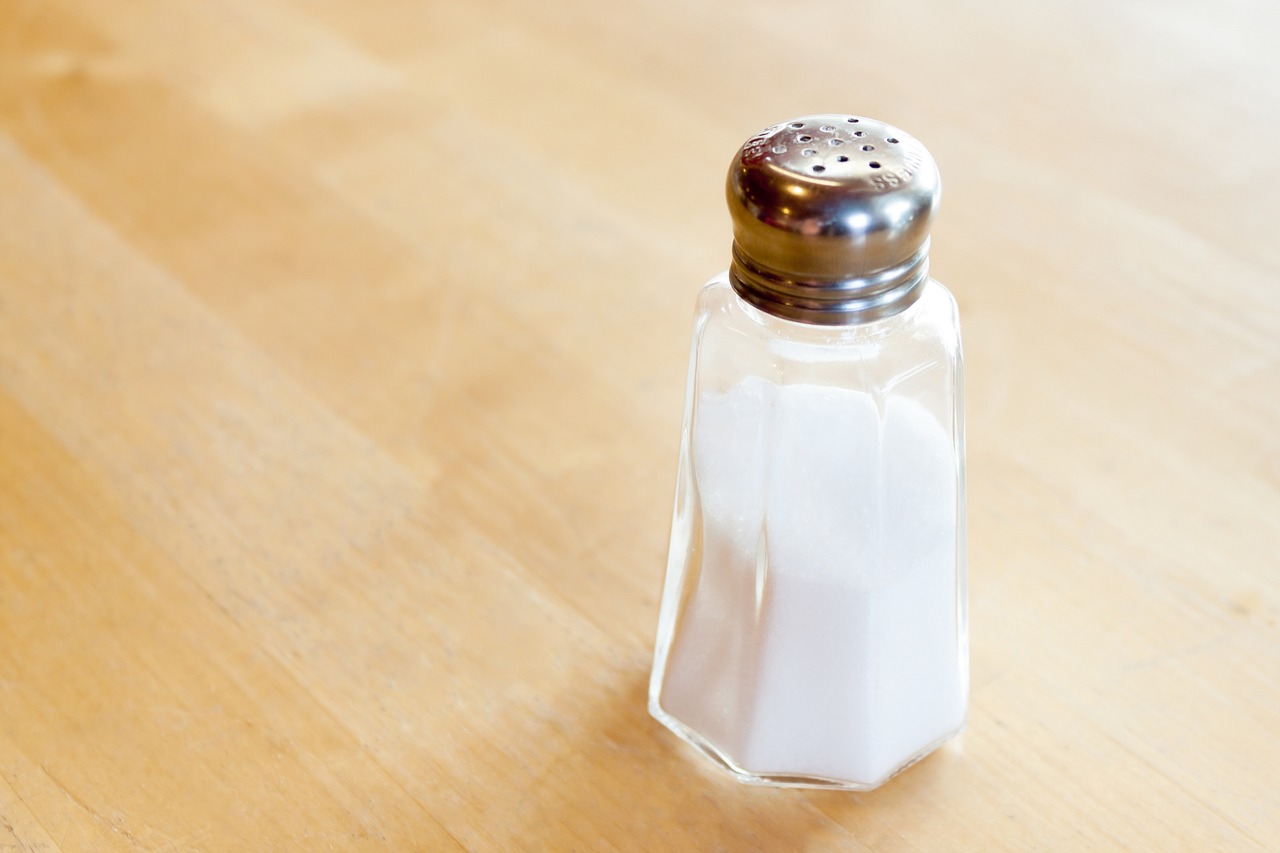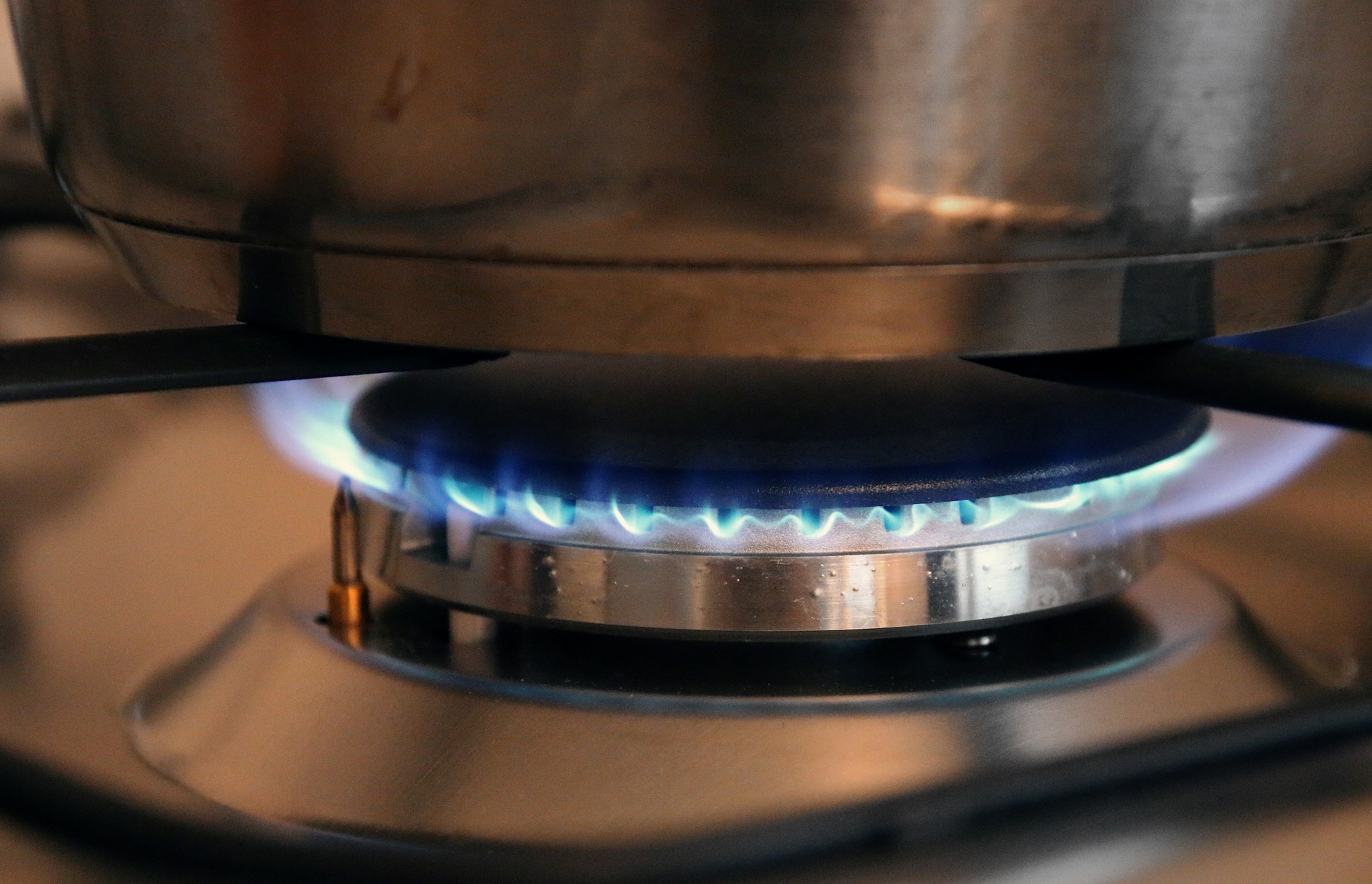21 3.8 Chemical Reactions
Created by: CK-12/Adapted by Christine Miller
Is It Magic?

The harmless-looking bottle in Figure 3.8.1 contains a greenish-yellow, poisonous gas. The gas is chlorine, which is also used as bleach and to keep the water in pools and hot tubs free of germs. Chlorine can kill just about anything. Would you breathe in chlorine gas or drink liquid chlorine? Of course not, but you often eat a compound containing chlorine. You probably eat this chlorine compound just about every day. Can you guess what it is? It’s table salt.

Table salt is actually sodium chloride (NaCl), which forms when chlorine and sodium (Na) combine in certain proportions. How does the toxic green chemical chlorine change into the harmless white compound we know as table salt? It isn’t magic — it’s chemistry, and it happens in a chemical reaction.
What Is a Chemical Reaction?
A chemical reaction is a process that changes some chemical substances into others. A substance that starts a chemical reaction is called a reactant, and a substance that forms as a result of a chemical reaction is called a product. During the reaction, the reactants are used up to create the products.
The burning of methane gas, as shown in the picture below, is a chemical reaction. In this reaction, the reactants are methane (CH4) and oxygen (O2), and the products are carbon dioxide (CO2) and water (H2O). As this example shows, a chemical reaction involves the breaking and forming of chemical bonds, which are forces that hold together the atoms of a molecule. When methane burns, for example, bonds break within the methane and oxygen molecules, and new bonds form in the molecules of carbon dioxide and water.

Chemical Equations
Chemical reactions can be represented by chemical equations. A chemical equation is a symbolic way of showing what happens during a chemical reaction. The burning of methane, for example, can be represented by the chemical equation:
CH4 + 2O2 → CO2 + 2H2O
The arrow in a chemical equation separates the reactants from the products, and shows the direction in which the reaction proceeds. If the reaction could occur in the opposite direction as well, two arrows pointing in opposite directions would be used. The number 2 in front of O2 and H2O, called the coefficient, shows that two oxygen molecules and two water molecules are involved in the reaction. If just one molecule is involved, no number is placed in front of the chemical symbol. Note the subscript of 2 for the oxygen (O) and hydrogen (H) atoms in the oxygen and water molecules, respectively. That tells you that each oxygen molecule is made up of two oxygen atoms. If there is no subscript, then there is a single atom. Thus, one water molecule is made up of two hydrogen atoms and one oxygen atom. In order for this chemical reaction to take place, one methane molecule reacts with two oxygen molecules to form one carbon dioxide molecule and two water molecules.

Conservation of Mass
In a chemical reaction, the quantity of each element does not change. There is the same amount of each element in the products as there was in the reactants. Mass is always conserved. According to the law of conservation of mass — which was first demonstrated convincingly by French chemist Antoine Lavoisier in 1785 — mass is neither created nor destroyed during a chemical reaction. Therefore, during a chemical reaction, the total mass of products is equal to the total mass of reactants. The conservation of mass is reflected in a reaction’s chemical equation. The same number of atoms of each element appears on each side of the arrow. In the chemical equation above, there are four hydrogen atoms on each side of the arrow. Can you find all four of them on each side of the equation?
Chemical vs. Physical Changes
Many processes that happen all around us on a daily basis involve chemical reactions. Not every change, however, is a chemical change. Some changes are simply physical and do not involve chemical reactions. Physical changes include change in size of pieces and change in state. If you break an eggshell and pour out the egg into a pan, its chemical makeup and properties do not change. This is just a physical change. No chemical reactions have occurred, and no chemical bonds have broken or formed. Other examples of physical changes are cutting paper into smaller pieces and letting an ice cube melt. What if you put the egg in the pan over a hot flame? The egg turns to a rubbery solid and changes colour. The properties of the egg have changed because its chemical makeup has changed. Cooking the egg is a chemical change that involves chemical reactions.
Other common examples of chemical changes include a cake baking, metal rusting, and a candle burning. More practice is below.
Figure 3.8.5 Chemical changes often involve chemical reactions as well.
3.8 Summary
- A chemical reaction is a process that changes some chemical substances into others. A substance that starts a chemical reaction is called a reactant, and a substance that forms during a chemical reaction is called a product. During the chemical reaction, bonds break in reactants and new bonds form in products.
- Chemical reactions can be represented by chemical equations. According to the law of conservation of mass, mass is always conserved in a chemical reaction, so a chemical equation must be balanced, with the same number of atoms of each type of element in the products as in the reactants.
- Many chemical reactions — such as iron rusting and organic matter rotting — occur all around us each day, but not all changes are chemical processes. Some changes — like ice melting or paper being torn into smaller pieces — are physical processes that do not involve chemical reactions and the formation of new substances.
3.8 Review Questions
- What is a chemical reaction?
- Define the reactants and products in a chemical reaction.
- List three examples of common changes that involve chemical reactions.
- Define a chemical bond.
- What is a chemical equation? Give an example.
- What does it mean for a chemical equation to be balanced? Why must a chemical equation be balanced?
- Our cells use glucose (C6H12O6) to obtain energy in a chemical reaction called cellular respiration. In this reaction, six oxygen molecules (O2) react with one glucose molecule. Answer the following questions about this reaction:
- How many oxygen atoms are in one molecule of glucose?
- Write out what the reactant side of this equation would look like.
- In total, how many oxygen atoms are in the reactants? Explain how you calculated your answer.
- In total, how many oxygen atoms are in the products? Is it possible to answer this question without knowing what the products are? Why or why not?
- Answer the following questions about the following equation: CH4+ 2O2 → CO2 + 2H2O
- Can carbon dioxide (CO2)transform into methane (CH4) and oxygen (O2) in this reaction? Why or why not?
- How many molecules of carbon dioxide (CO2) are produced in this reaction?
- Is the evaporation of liquid water into water vapor a chemical reaction? Why or why not?
- Why do bonds break in the reactants during a chemical reaction?
3.8 Explore More
The law of conservation of mass – Todd Ramsey, TED-Ed, 2015.
Chemical Changes: Crash Course Kids #19.2, by Crash Course Kids, 2015.
Attributions
Figure 3.8.1
Chlorine_gas_in_high_concentration by Larenmclane on Wikimedia Commons, is used under a CC BY-SA 4.0 (https://creativecommons.org/licenses/by-sa/4.0/deed.en) license.
Figure 3.8.2
Tags: Salt Salt Shaker Spices Kitchen Spice Component; salt-4160306_1280 by katie175 from Pixabay is used under the Pixabay License (https://pixabay.com/de/service/license/).
Figure 3.8.3
Tags: Gas Flame Gas Stove Italy Gas Cook Kitchen by moerschy from Pixabay is used under the Pixabay License (https://pixabay.com/de/service/license/).
Figure 3.8.4
Antoine_lavoisier by unknown on Wikimedia Commons has been adapted by Christine Miller. The orginal work, believed to be from http://www.schuster-ingolstadt.de/Chemie.htm has been released into the public domain (https://en.wikipedia.org/wiki/Public_domain).
Figure 3.8.5
- Ice cream melting by Aron Visuals on Unsplash is used under the Unsplash License (https://unsplash.com/license).
- Kombucha [photo] by Klara Avsenik on Unsplash is used under the Unsplash License (https://unsplash.com/license).
- Grated cheese by Steve Buissinne on PublicDomainPictures is used under the CC0 1.0 Universal Public Domain Dedication license (https://creativecommons.org/publicdomain/zero/1.0/).
References
Crash Course Kids. (2015, July 16). Chemical changes: Crash Course Kids #19.2. YouTube. https://www.youtube.com/watch?v=37pir0ej_SE
TED-Ed. (2015, February 26 ). The law of conservation of mass – Todd Ramsey. YouTube. https://www.youtube.com/watch?v=2S6e11NBwiw&feature=emb_logo
Wikipedia contributors. (2020, June 15). Antoine Lavoisier. Wikipedia. https://en.wikipedia.org/w/index.php?title=Antoine_Lavoisier&oldid=962631283
A chemical reaction is a process that leads to the chemical transformation of one set of chemical substances to another.
A substance that takes part in and undergoes change during a chemical reaction.
A substance that is formed as the result of a chemical reaction.
A lasting attraction between atoms, ions or molecules that enables the formation of chemical compounds.
An expression that gives the identities and quantities of the substances involved in a reaction. A chemical equation shows the starting compound(s)—the reactants—on the left and the final compound(s)—the products—on the right, separated by an arrow.
The law of conservation of mass states that mass can neither be created nor destroyed in a chemical reaction. Thus, the amount of matter cannot change.

